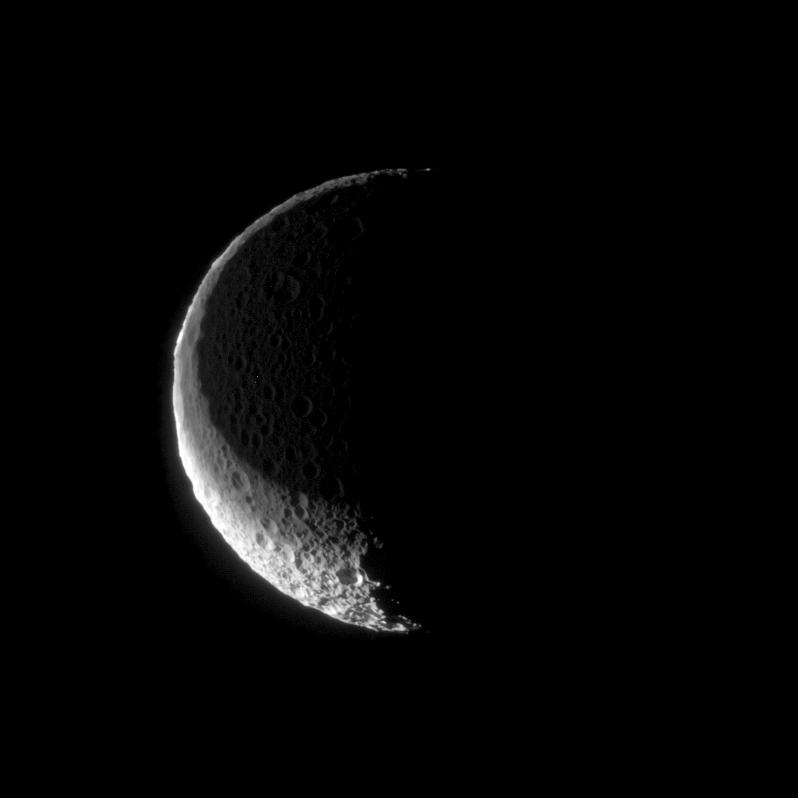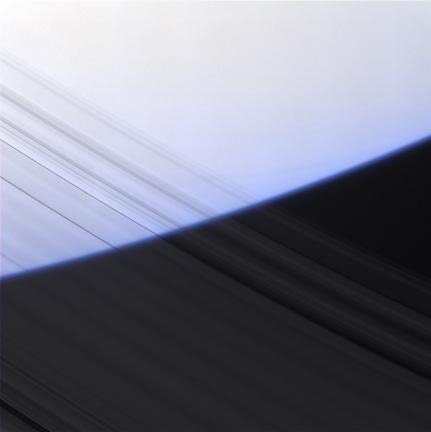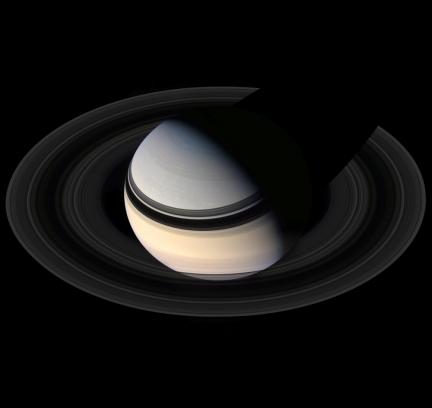 Prometheus is the small moon that shepherds Saturn’s outer “F” ring and causes those crazy waves in the particles that make up the ring itself. The phenomenon has been the theme of at least 3 different animations here on wanderingspace.net. The image above is what that small moon in those animations looks like from 60,000 km taken by Cassini on Dec 26, 2009.
Prometheus is the small moon that shepherds Saturn’s outer “F” ring and causes those crazy waves in the particles that make up the ring itself. The phenomenon has been the theme of at least 3 different animations here on wanderingspace.net. The image above is what that small moon in those animations looks like from 60,000 km taken by Cassini on Dec 26, 2009.
Rings Not Entirely Flat
 Recent observations of Saturn’s rings from Cassini reveal some vertical structure to the rings. Shown here are disturbances caused by Daphnis, a small moonlet that orbits within the Keeler Gap of the rings. We have seen much of these kinds of disturbances in the rings from tiny moonlets, but the Saturninan equinox finally provides us with an angle of sunlight that reveals such structures from the long shadows they cast. The tallest shadow seen at right is Daphnis itself.
Recent observations of Saturn’s rings from Cassini reveal some vertical structure to the rings. Shown here are disturbances caused by Daphnis, a small moonlet that orbits within the Keeler Gap of the rings. We have seen much of these kinds of disturbances in the rings from tiny moonlets, but the Saturninan equinox finally provides us with an angle of sunlight that reveals such structures from the long shadows they cast. The tallest shadow seen at right is Daphnis itself.
More Gordan U

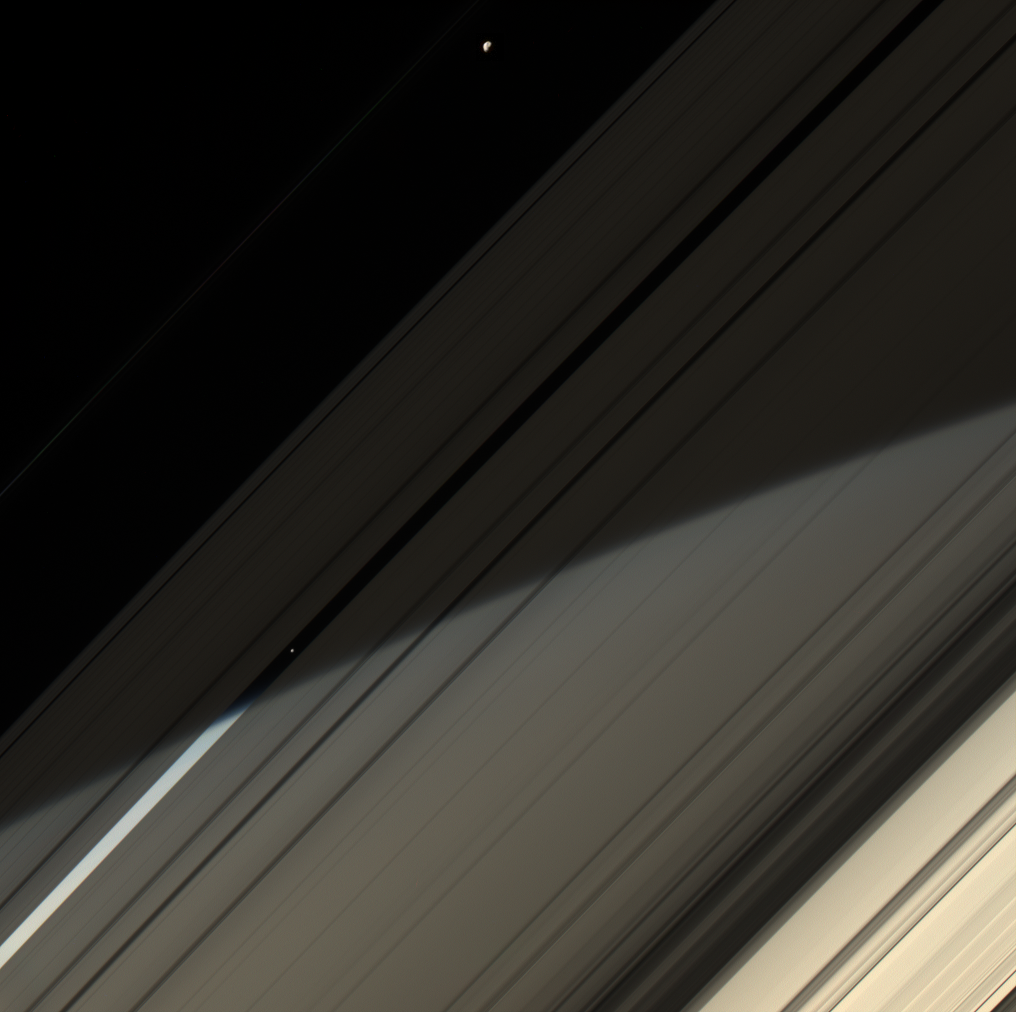

 Some recent posts from Gordan Ugarkovic. The first is just gorgeous, the second featuring Prometheus and Pan in the gaps, the third is also just real pretty and the 4th is two sides of Enceladus. The 2nd and 4th of these images are false color which we publish less often, but these were just too nice to deny.
Some recent posts from Gordan Ugarkovic. The first is just gorgeous, the second featuring Prometheus and Pan in the gaps, the third is also just real pretty and the 4th is two sides of Enceladus. The 2nd and 4th of these images are false color which we publish less often, but these were just too nice to deny.
Saturnati XX
Prometheus (the Movie)
 Yes, another movie of Prometheus disturbing Saturn’s rings. This is the longest clip and includes the most ring swinging action for your money. This version has been cropped and reduced down from the original. See here for a larger, wider view of the same animation (2M gif).
Yes, another movie of Prometheus disturbing Saturn’s rings. This is the longest clip and includes the most ring swinging action for your money. This version has been cropped and reduced down from the original. See here for a larger, wider view of the same animation (2M gif).
Modern Art
Rhea Under Rings
Dramatic Saturn
Mimas in Ring Shadow
Tethys and Saturnian Rings
Prometheus Spreads its Magic!
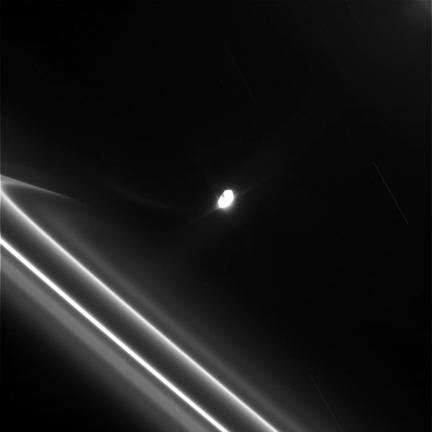 From the raw images of the Cassini mission. This is Saturn’s tiny moon Prometheus causing a disturbance in some ring particles. Nothing really new to be said here as we have seen this featured in a few animations posted here before. This is just a nice image of that phenomenon with the addition of a nice glaringly over-exposed Prometheus.
From the raw images of the Cassini mission. This is Saturn’s tiny moon Prometheus causing a disturbance in some ring particles. Nothing really new to be said here as we have seen this featured in a few animations posted here before. This is just a nice image of that phenomenon with the addition of a nice glaringly over-exposed Prometheus.
Saturnati XVIII
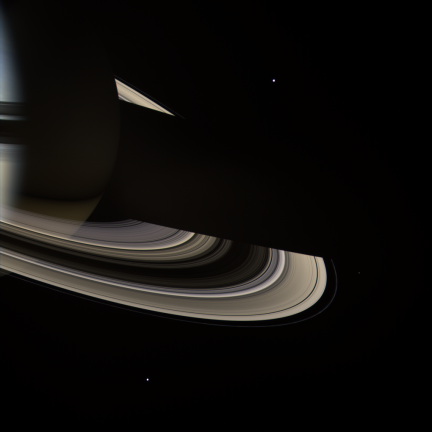 Another Ugarkovic Beauty. Visible in the image are also Enceladus, Epimetheus and Mimas.
Another Ugarkovic Beauty. Visible in the image are also Enceladus, Epimetheus and Mimas.
Transparent Rings
A Grid of Rings
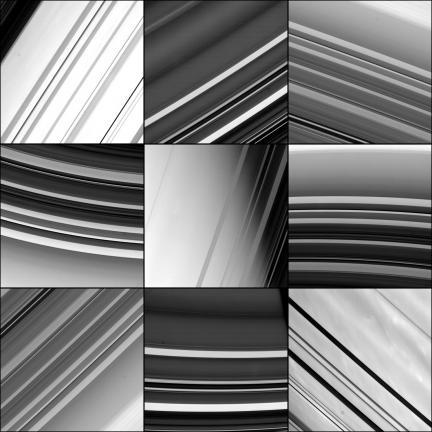 Looking at the 500 most recent raw images from Cassini, one of the pages was filled with nothing but images of the rings at various angles and locations. The tiling of these images on one page was unintentionally interesting and I thought we would repeat a more intentional version here with those same images.
Looking at the 500 most recent raw images from Cassini, one of the pages was filled with nothing but images of the rings at various angles and locations. The tiling of these images on one page was unintentionally interesting and I thought we would repeat a more intentional version here with those same images.
Saturnati X
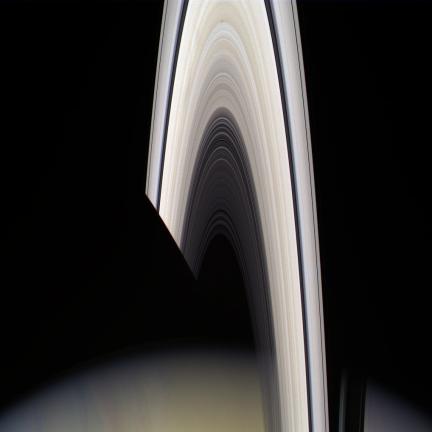 This image taken on January 18, 2008 from 988,018 km,
This image taken on January 18, 2008 from 988,018 km, 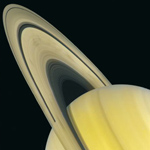 reminds one of some of those vintage Voyager images of Saturn (seen at left) from back in the early and mid 1980’s. Just compare at the incredible differences between the quality and color of the Voyager vs. Cassini images. Saturn images during the Voyager era were all consistently yellow and brown, but today’s Cassini images reveal Saturn to be a rich peach color mixed with hints of yellow and brown. We also have the advantage of being witness to the rich blues currently appearing in the northern hemisphere which did not exist in 1981 or 1986.
reminds one of some of those vintage Voyager images of Saturn (seen at left) from back in the early and mid 1980’s. Just compare at the incredible differences between the quality and color of the Voyager vs. Cassini images. Saturn images during the Voyager era were all consistently yellow and brown, but today’s Cassini images reveal Saturn to be a rich peach color mixed with hints of yellow and brown. We also have the advantage of being witness to the rich blues currently appearing in the northern hemisphere which did not exist in 1981 or 1986.
F-Ring Animation
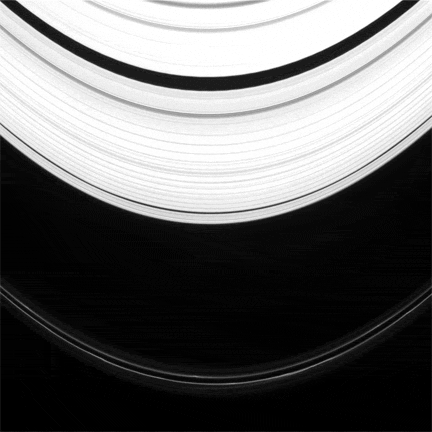 Prometheus disturbing the F-Ring as it passes. We have seen this animated before, but perhaps not from such a vantage point.
Prometheus disturbing the F-Ring as it passes. We have seen this animated before, but perhaps not from such a vantage point.
The Regan Saturn Portrait Extended Mix
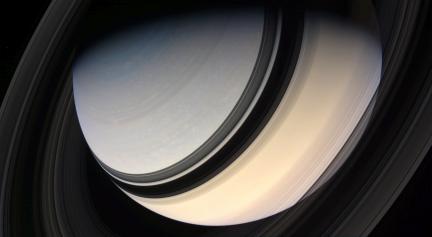 The one Saturn image that we keep coming back to at wanderingspace seems to be the Ian Regan portrait of Saturn. The composition, angle and color captured in the shot somehow seem to be better than any other. While there are a few other full Saturn images now available from the Cassini mission, none seem to have captured the drama that this one does. The angle that the ring shadows fall on Saturn’s disc, the phase that Saturn happened to be in at the time and the color available as the shot was taken from a more northern position. However, trying to apply the image to larger scale resolutions was not possible as the resolution in the orignal would require that the rings be extended to fill the frame on the left, right, bottom and potentially the top as well (I was also curious to see if the image was just as impressive if it was not angled and cropped as it is in the original). Extending the rings in one direction is easy enough, but doing it on all sides is near impossible to try to do in any image editing software such as Photoshop.
The one Saturn image that we keep coming back to at wanderingspace seems to be the Ian Regan portrait of Saturn. The composition, angle and color captured in the shot somehow seem to be better than any other. While there are a few other full Saturn images now available from the Cassini mission, none seem to have captured the drama that this one does. The angle that the ring shadows fall on Saturn’s disc, the phase that Saturn happened to be in at the time and the color available as the shot was taken from a more northern position. However, trying to apply the image to larger scale resolutions was not possible as the resolution in the orignal would require that the rings be extended to fill the frame on the left, right, bottom and potentially the top as well (I was also curious to see if the image was just as impressive if it was not angled and cropped as it is in the original). Extending the rings in one direction is easy enough, but doing it on all sides is near impossible to try to do in any image editing software such as Photoshop.

Instead, a one pixel wide swash of the rings was sampled and turned into vectors using Adobe Illustrator. This further allows Illustrator to stretch and curve the ring information captured without having to worry about resolution or pixel distortion. The row of rings was then applied to a brush pattern and applied and wrapped to a simple circle shape. Now the rings are in full circle and the proportions are adjusted. That full set of rings was then rendered in 3-D software and the correct angle as well as perspective was applied and matched with the original Ian Regan image underneath the render for reference.
After that, all that is left to do is merge the Regan image to the rings (and maintain as much of the original image as possible) and artificially add the disc shadow that would fall upon the rings behind the planet iteself.
To see the image in hi-res use check out the 2560x1600 wallpaper sets for The Planets and Saturn Scenes
Prometheus Desturbs a Ring
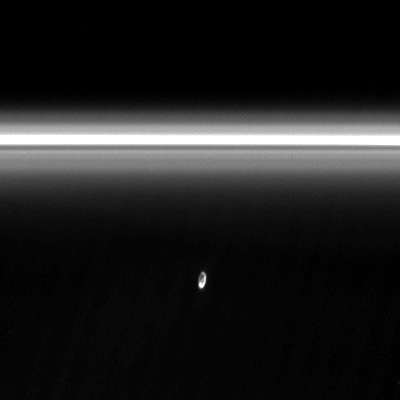 There have been some nice NASA animations of the interaction between some “shepard” moons and the rings, but this has to be the most impressive. There are some blank frames in there for gaps in the data… but the effect is still easy to follow.
There have been some nice NASA animations of the interaction between some “shepard” moons and the rings, but this has to be the most impressive. There are some blank frames in there for gaps in the data… but the effect is still easy to follow.
2560 x 1600 Set 05 : Saturn Scenes
Among the various worlds in our celestial neighborhood, Saturn stands apart as a most photogenic. With the help of a complex system of rings it naturally lends itself to more scenic images as compared to the more detail oriented images we see from such other places such as Mars or Jupiter. The “Saturn Scenes” set (downloadable here as a zipped file) was compiled from some of the best scenic images from the Cassini mission that had the potential to fill a 2560x1600 frame.
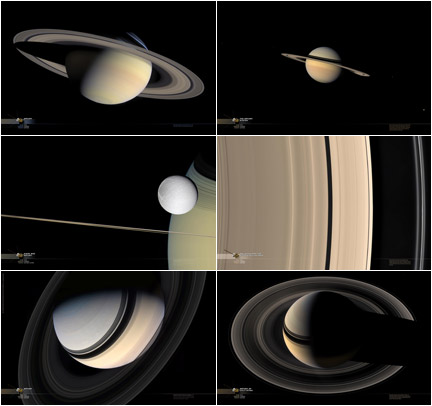
In order to completely fill that frame out some rendering and sampling has been applied to the original images. These additions are briefly noted in the images themselves and are as noted here…
DIONE AND SATURN features the moon Dione passing in front of the edge of Saturn’s disc. The original image would only fill about 1/4 of the frame so some of the details have been sampled and expanded to fill out that full frame’s proportions. The details of the rings are sampled from this image and based upon other photographic references. The left 2/3 of the rings seen here were rendered and are not actual. The lower 1/5 of Saturn’s disc was sampled and extended from the original image. Lastly, the top darkest ring shadows were rendered based upon a fair amount of actual data that was actually present in the original but was cropped short.
SATURN (which is named “SATURN-2.jpg” in the file name) has had a considerable amount of rendering to extend the details of the rings to fill out this larger 2560x1600 frame. The original color composite work was masterfully performed by Ian Regan for unmannedspaceflight.com and has become a wanderingspace favorite. In order to extend the rings to fill out the frame as accurately as possible, a one pixel wide sampling of the full set of rings was captured and digitally translated to vectors. These vectors were then stretched and applied to a circle path which was then rendered in 3-D software to achieve the correct perspective of the original. Once a match was made, the new vector based rings were then blended into the actual original image and some masking was applied to represent Saturn’s shadow falling upon the rings. Despite the heavily rendered nature of the rings, virtually no part of the disc of Saturn itself has been altered and is 99.5% original and actual.
All other images are actual and unaltered.
Cassini Team Shows Some Color
NASA released an unusually large amount of color images to the Cassini website recently. Most of what is shown here on this site are actually images put together by freelance imagers who access the raw files and do some stitching together of filtered images. Color images coming straight off the Cassini website are a rare event, so when about 8 appeared in the gallery a few days ago… it was an unexpected gift.
 Saturn as seen from the unlit side of the rings.
Saturn as seen from the unlit side of the rings.
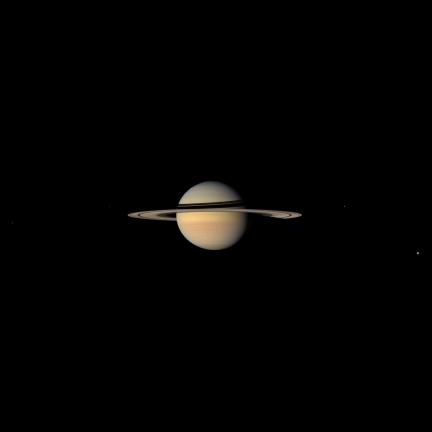 A family portrait of the Saturn System. Moons visible in this image (you need to click the preview) are Dione at far left, Enceladus near the left side ring edge, Mimas a speck on ring shadows on the western limb, Rhea against the northern hemisphere, Tethys near the right ring edge, and Titan near lower right.
A family portrait of the Saturn System. Moons visible in this image (you need to click the preview) are Dione at far left, Enceladus near the left side ring edge, Mimas a speck on ring shadows on the western limb, Rhea against the northern hemisphere, Tethys near the right ring edge, and Titan near lower right.
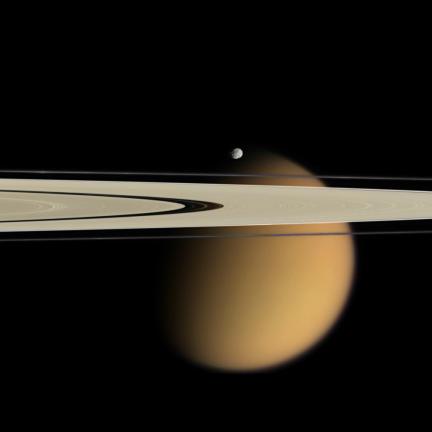 Titan and a small moonlet named Epimetheus share the frame with Saturn’s rings.
Titan and a small moonlet named Epimetheus share the frame with Saturn’s rings.
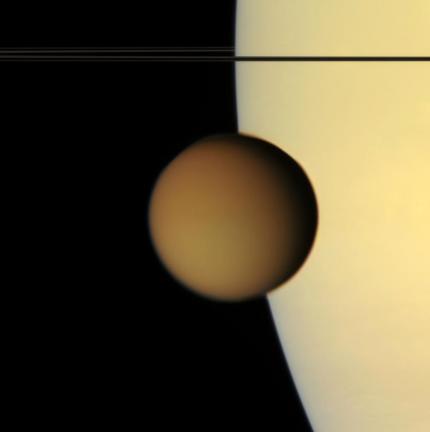 A rare color view of both Saturn and Titan in one frame. This is the only one of its kind thus far in the mission.
A rare color view of both Saturn and Titan in one frame. This is the only one of its kind thus far in the mission.
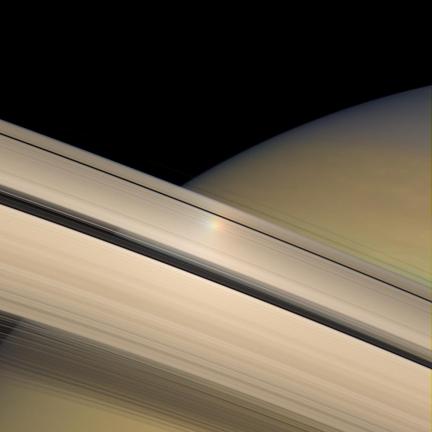 A small rainbow appears as sunlight streams through Saturn’s rings.
A small rainbow appears as sunlight streams through Saturn’s rings.




